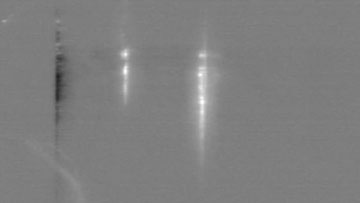
An ultrafast X-ray imaging technique has been used to record the propagation of sound waves in a diamond crystal. [Image: Theodor S. Holstad et al. / DTU)
A team of scientists in Denmark and the United States has for the first time captured the propagation of sound waves through a solid material, in this case a single crystal of diamond 1 mm thick (Proc. Natl. Acad. Sci., doi: 10.1073/pnas.2307049120). The researchers say their ultrafast X-ray imaging technique, which exploits a purpose-built microscope attached to the output of an X-ray free-electron laser (XFEL), offers a way to visualize structural processes in bulk solids at sub-picosecond timescales—six orders of magnitude faster than is possible with existing techniques.
Fast and noninvasive
X-ray imaging using synchrotron radiation already enables scientists to study nanometer-scale structural processes in the millisecond regime. But that is not fast enough to investigate fundamental physical effects that are governed by lattice dynamics, such as the transfer of heat or phase transitions that occur at specific pressures and temperatures.
“We want to see these changes in 3D, but until now it couldn't be done fast enough or without damaging the crystals,” explains lead author Henning Friis Poulsen, Technical University of Denmark. “Our new technology can do it faster and noninvasively and will work for many crystals.”
The experimental setup exploits a technique called dark-field X-ray microscopy (DFXM), which has previously been used at synchrotron facilities to produce 3D maps of the structure and local strain within solid materials. Working with the more intense pulses delivered by an XFEL required a new instrument to be designed and built from scratch, and the team also devised a pump–probe scheme to record the local distortions in the crystal lattice created by the sound waves as they travel through the material.
Imaging acoustic waves
The same technique could be used to study ultrafast structural dynamics in a range of solid materials, including metals, ceramics and rock.
In this approach, a femtosecond laser is first used to generate acoustic waves in the sample, with X-ray pulses then used to produce a 2D snapshot of the local strain in the crystal. Repeating the experiment with different time delays between the optical pump and X-ray probe pulses yielded time-resolved movies that reveal the movement of sound waves through the material, as well as the dissipation of the initial mechanical impulse over microsecond timescales.
The same technique could be used to study ultrafast structural dynamics in a range of solid materials, including metals, ceramics and rock. By probing the interactions between strain waves and structural elements such as dislocations, grain boundaries and voids, it could be particularly important for understanding phonon behavior in solid-state systems such as metamaterials, photonic crystals and soft materials such as hybrid perovskites.
The researchers believe that the technique could also enable the visualization of irreversible structural processes, such as martensitic phase transformations in steel, domain switching in ferroelectrics and dielectric breakdown. They write that extending the technique to polycrystalline materials could enable its use in geoscience to test seismological models of sound propagation in planetary materials.
